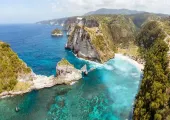Remembering the Second World War on Saipan Island
Catalogue
- Banzai Cliff:Japanese Jumped into the Sea to Commit Suicide During World War II
- Suicide Cliff:Japanese Jumped into the Sea to Commit Suicide During World War II
- Last Command Post of the Japanese:Cannons and Other Weapons Visible
- Martyr Stele:Memorial in Commemoration of World War II Suicide
- Saipan Island's Peace Park:Visit the Weapons of War
- Atomic Bomb Pits:Launching the Japanese Atomic Bomb Takes off Here
Show More
As an important island in the Pacific Ocean, Saipan was fought over fiercely by the Japanese and U.S. armies during the second world war. Nowadays the smoke has long since blown over, but the relics of those years are still in place, never letting visitors forget that period of history.
Banzai Cliff is at the northernmost tip of the island, overhanging the giant, rolling waves of the Pacific Ocean. From this vantage point, one can admire the different colors of the Pacific waters, as well as the white surf crashing against the shore at one's feet.
When Japan lost the second world war, the Japanese, unwilling to give themselves up, went up to Banzai Cliff--old and young alike, women and children too--and with a last cry of "Long live the Emperor!" they jumped as one to their deaths. "Banzai" is the Japanese word for "long live."
This 360-degree oceanic panorama, embattled by the fierce waves, could hardly be more different from the calm, still waters on the west coast of the island. Standing close to the sea railing, apart from admiring the spectacular sheer precipice, one also gets a sense of being hemmed in by the water and the waves.

Suicide Cliff is the highest point on the north of Saipan Island, situated adjacent to the relics of the last command post of the Japanese army. It is not far from Banzai Cliff. This is the other suicide spot of the Japanese army on Saipan Island, besides Banzai Cliff.
Most of the people who visit nowadays are tourists. Apart from those coming to learn about the history, a large contingent of Japanese also come every year to pay their respects.

The relics of the last command post of the Japanese army are located at the foot of Suicide Cliff in the north of the island. Relics left over from the second world war, including tanks and cannons, can be seen everywhere outside the post, a rusty testimony to history.
In the war, the Japanese, out of ammunition and supplies, ultimately could not resist the U.S. onslaught. It was here that the commander-in-chief committed harakiri, or disemboweling himself.
These days the site has been turned into a small lush green garden. The outside of the garden is well planted with royal poinciana trees, their orange-red leaves strewn below, momentarily blanketing the memory of the raging battle that went before.

The Monument to Loyal Souls stands near Banzai Cliff. There is a wooden walkway behind it, which visitors can descend to stand by the cliff and admire the different colors of the vast Pacific waters close by, as well as the white surf crashing against the shore at one's feet.
Historical background: The Monument to Loyal Souls is also known as the "chewing gum monument.” It was erected to commemorate the Japanese soldiers who jumped to their deaths at this spot during the war.
It has been reported that many tourists from countries that suffered in the war, such as Korea, have stuck chewing gum all over the monument to express their anger towards the Japanese. Hence the locals' nickname for it--the "chewing gum monument."

Saipan Island's Peace Park is a tiny park located above Suicide Cliff. On display here are various weapons left by the Japanese army after the second world war.
The park was built to commemorate and mourn those injured and killed in the war. It can be visited in combination with Suicide Cliff.
The park contains a massive royal poinciana tree, behind which are a large number of gravestones, including the graves of the dozens of Japanese female students who were raped and then forcibly thrown off the cliff by Japanese soldiers.
There is a small square in the park with a monument in the middle that was jointly erected by Japan and America.

This is the old base on Tinian Island where the atomic bombs that the U.S. dropped on Hiroshima and Nagasaki during the second world war were loaded aboard the planes.
At 2:45 AM on August 6, 1945, the B-29 bomber Enola Gay, carrying an atomic bomb named Little Boy, took off from here, opening its bays over Hiroshima at 8:15 AM.
Three days later, at 11:02 AM on August 9, the bomber carrying the second bomb, Fat Man, also took off from here, later to drop it over Nagasaki. The destruction these two bombs wrought on Japan ensured that six days later, on August 15, the Emperor announced its unconditional surrender.
Nowadays the memorial is encased in glass. Visitors can peer through to see what is inside, and there is a plaque erected on a standing stone to one side to explain how the atomic bombs came to be loaded up here all those years ago.

Trending Travelogues
Popular Trip Moments
Popular Attractions
Popular Ranked Lists
Popular Destinations
Recommended Attractions at Popular Destinations
About











Site Operator: Trip.com Travel Singapore Pte. Ltd.







